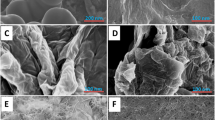Abstract
Carbon-based materials, such as diamond-like carbon (DLC), carbon nanofibers (CNFs), and carbon nanotubes (CNTs), are inherently interesting for neurotransmitter detection due to their good biocompatibility, low cost and relatively simple synthesis. In this paper, we report on new carbon-hybrid materials, where either CNTs or CNFs are directly grown on top of tetrahedral amorphous carbon (ta-C). We show that these hybrid materials have electrochemical properties that not only combine the best characteristics of the individual “building blocks” but their synergy makes the electrode performance superior compared to conventional carbon based electrodes. By combining ta-C with CNTs, we were able to realize electrode materials that show wide and stable water window, almost reversible electron transfer properties and high sensitivity and selectivity for detecting dopamine in the presence of ascorbic acid. Furthermore, the sensitivity of ta-C + CNF hybrids towards dopamine as well as glutamate has been found excellent paving the road for actual in vivo measurements. The wide and stable water window of these sensors enables detection of other neurotransmitters besides DA as well as capability of withstanding higher potentials without suffering from oxygen and hydrogen evolution.







Similar content being viewed by others
References
Wittchen H, Jacobi F, Rehm J, Gustavsson A, Svensson M, Jönsson B, Olesen J, Allgulander C et al (2011) Cost of disorders of the brain in Europe 2010. Eur Neuropsychopharmacol 21:655–679. doi:10.1016/j.euroneuro.2011.08.008
Murray CJL et al (2013) The state of US health, 1990-2010: burden of diseases, injuries, and risk factors. JAMA. doi:10.1001/jama.2013.13805
Nguyen-Vu TDB, Chen H, Cassell AM, Andrews R, Meyyappan M, Li J (2006) Vertically aligned carbon nanofiber arrays: an advance toward electrical-neural interfaces. Small 2:89–94. doi:10.1002/smll.200500175
Benabid A. L (2003) Deep brain stimulation for Parkinson’s disease. Current opinion in neurobiology 13:696-706. doi:10.1016/j.conb.2003.11.001
Kaivosoja E, Sainio S, Lyytinen J, Palomäki T, Laurila T, Kim S, Han J, Koskinen J (2014) Carbon thin films as electrode material in neural sensing. Surf Coat Technol. doi:10.1016/j.surfcoat.2014.07.056
Laurila T, Rautiainen A, Sintonen S, Jiang H, Kaivosoja E, Koskinen J (2014) Diamond-like carbon (DLC) thin film bioelectrodes: effect of thermal post treatments and the use of Ti adhesion layer. Mater Sci Eng C: Mater Biol Appl 34:446–454. doi:10.1016/j.msec.2013.09.035
Kaivosoja E, Berg E, Rautiainen A, Palomaki T, Koskinen J, Paulasto-Krockel M, Laurila T, (2013) Improving the function of dopamine electrodes with novel carbon materials. Conf Proc IEEE Eng Med Biol Soc. 632–634. doi: 10.1109/EMBC.2013.6609579
Schnuppa R, Kühnholdb R, Temmela G, Burtea E, Ryssel H (1998) Thin carbon films as electrodes for bioelectronic applications. Biosens Bioelectron 13:889–894. doi:10.1016/S0956-5663(98)00057-8
Robertson J (2002) Diamond-like amorphous carbon. Mater Sci Eng R 37:129–281. doi:10.1016/S0927-796X(02)00005-0
Laurila T, Protopopova V, Rhode S, Sainio S, Palomäki T, Moram M, Feliu J, Koskinen J (2014) New electrochemically improved tetrahedral amorphous carbon films for biosensor applications. Diam Relat Mater. doi:10.1016/j.diamond.2014.08.007
Sainio S, Palomäki T, Rhode S, Kauppila M, Pitkänen O, Selkälä T, Toth G, Moram M et al (2015) Carbon nanotube (CNT) forest grown on diamond-like carbon (DLC) thin films significantly improves electrochemical sensitivity and selectivity towards dopamine. Sensors Actuators B 211:177-186 doi:10.1016/j.snb.2015.01.059
Pitkänen O, Halonen N, Leino A-R, Mäklin J, Dombovari A, Lin JH, Toth G, Kordas K (2013) Low-temperature growth of carbon nanotubes on bi- and tri-metallic catalyst templates. Top Catal 56:522–526. doi:10.1007/s11244-013-0047-9
Streeter I, Wildgoose GG, Shao L, Compton RG (2008) Cyclic voltammetry on electrode surfaces covered with porous layers: an analysis of electron transfer kinetics at single-walled carbon nanotube modified electrodes. Sensors Actuators B 133:462–466. doi:10.1016/j.snb.2008.03.015
Keeley GP, Lyons MEG (2009) The effects of thin layer diffusion at glassy carbon electrodes modified with porous films of single-walled carbon nanotubes. Int J Electrochem Sci 4:794–809
Rand E, Periyakaruppan A, Tanaka Z, Zhang DA, Marsh MP, Andrews RJ, Lee KH, Chen B et al (2012) A carbon nanofiber based biosensor for simultaneous detection of dopamine and serotonin in the presence of ascorbic acid. Biosens Bioelectron 42:434–438. doi:10.1016/j.bios.2012.10.080
Periyakaruppan A, Gandhiraman RP, Meyyappan M, Koehne JE (2013) Label-free detection of cardiac troponin‑I using carbon nanofiber based nanoelectrode arrays. Anal Chem 85:3858–3863. doi:10.1021/ac302801z
Helveg S, López-Cartes C, Sehested J, Hansen P. L., Clausen B. S, Rostrup-Nielsen J. R, Abild-Pedersen F, Nørskov J. K (2004) Atomic-scale imaging of carbon nanofibre growth. Nature 427:426-429. doi:10.1038/nature02278
Taira T, Paalasmaa P, Voipio J, Kaila K (1995) Relative contributions of excitatory and inhibitory neuronal activity to alkaline transients evoked by stimulation of Schaffer collaterals in the rat hippocampal slice. J Neurophysiol 74:643–649
Voipio J, Paalasmaa P, Taira T, Kaila K (1995) Pharmacological characterization of extracellular pH transients evoked by selective synaptic and exogenous activation of AMPA, NMDA, and GABAA receptors in the rat hippocampal slice. J Neurophysiol 74:633–642
Acknowledgments
Dr. Emilia Kaivosoja (Aalto University, Espoo, Finland) and Olli Pitkänen (University of Oulu, Finalnd) are acknowledged for their assistance with carbon nanotube growth and glutamate measurements, respectively.
Author information
Authors and Affiliations
Corresponding author
Rights and permissions
About this article
Cite this article
Sainio, S., Palomäki, T., Tujunen, N. et al. Integrated Carbon Nanostructures for Detection of Neurotransmitters. Mol Neurobiol 52, 859–866 (2015). https://doi.org/10.1007/s12035-015-9233-z
Published:
Issue Date:
DOI: https://doi.org/10.1007/s12035-015-9233-z




